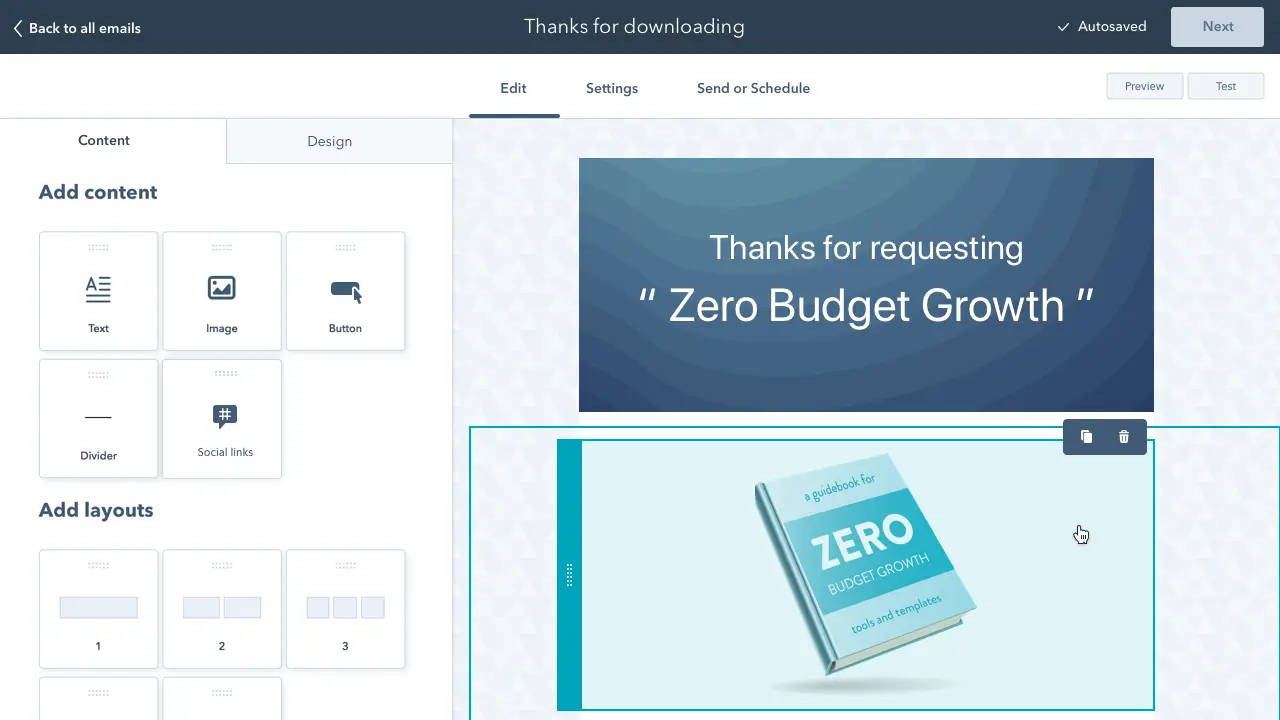However, when we begin to think about all the things that can negatively impact a sender’s reputation, we can easily end up in the weeds. I’ll discuss the things we can control to turn around sender reputation and effectively improve your chances of reaching the coveted primary inbox.
Table of Contents
What is email sender reputation?
Email sender reputation is a measurement of how trustworthy your bulk emails are to internet service providers (ISPs) like Gmail and Microsoft. Your email reputation determines whether your emails are given prime-time placement in the “primary” inbox tab, if they’re put in promotions, sent to the spam folder, or blocked from entering the inbox altogether.
That’s right: Access to people’s inboxes is a privilege that can be revoked by email mailbox providers.
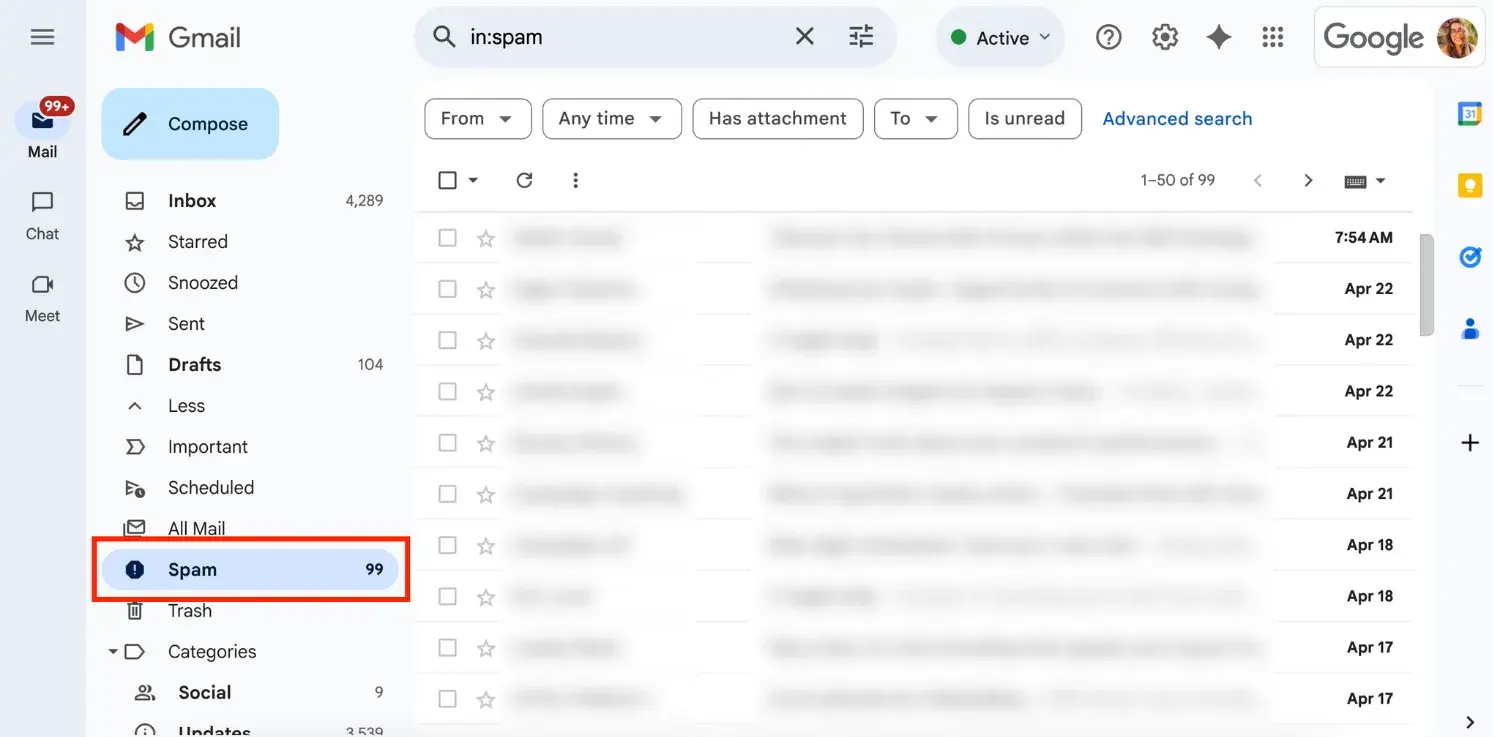
Your email reputation is positively impacted when users open, save, engage with, and forward your emails (among other factors — more on this in a minute). It’s negatively impacted when your emails are ignored, deleted, sent to spam, or when recipients mark them as spam.
This can be measured with a “sender score” using this free tool that does a simple scan of your domain. This numerical evaluation is a reflection of the IP and domain reputation, ranging from 1 to 100 (with 100 being the best).
The HubSpot Email Health tool provides a deeper look by gauging the data points from your email campaigns, offering you a rating between one and 10 (with 10 being the best):

Your email reputation is similar to your credit history: You use your credit card responsibly, and over time, build up a positive reputation. Unlike with your credit score, though, the factors that are causing your score to drop are not always obvious (more on this in a minute).
Why Your Email Sender Reputation Matters
I know it’s easy to brush off the importance of your email sender reputation when you’re wearing too many marketing hats already (raises hand). But the cold reality is: An email accidentally landing in spam is harmful to your entire email strategy.
Deployteq found these insights in its 2025 email benchmarking report:
- Average email acceptance rate — 99.5%.
- Average open rate — 51.8%.
- Average click-through rate — 5%.
- When comparing industries, business services have the lowest email acceptance rate at 93.4%.
- Business services also have the highest bounce rate at 6.6%.
More powerful email statistics from research around the web:
- Email isn’t new, but it’s stood the test of time and still offers a $36 return for every $1 spent.
- Business-to-consumer (B2C) brands said that email had the best channel ROI in our 2025 State of Marketing report.
- More than half of surveyed marketing professionals said that they were seeing improved ROI on email campaigns year over year.
To me, these statistics underscore what’s lost when you half-do email. This is why your sender reputation matters.
But what if you have a great sender score and your emails have high deliverability — do you need to think about your reputation at all? That’s exactly what I asked Amanda DeLuke, an email expert who has overseen tens of millions of marketing emails. Her answer was an immediate yes.
“Even if you have an excellent sender reputation and your deliverability rate is high, you can still be greatly affected by some simple slip-ups,” she shared. “You may be able to have a few slip-ups with a subject line, sending an accidental duplicate message, or sending with an exposed URL, but if you forget an unsubscribe link or start sending partner emails/ads to your list without being transparent, you could deal with some huge issues that are very hard to repair (even if you have a pristine sender reputation).”
Let’s dig into the factors that might be damaging your reputation without you even realizing it.
What factors impact your sender reputation?
There are many, many factors that impact your sender reputation and trigger spam filters. Some of those causes are technical, and others are behavioral. Let’s explore some of the most common ones.
DomainKeys Identified Mail (DKIM)
When a reputable brand ends up in the spam folder, what went wrong?
The first thing that Amanda DeLuke pointed to is DomainKeys Identified Mail (DKIM), an important form of email authentication. This protects email users from malicious/spam emails, while also protecting business owners from scammers impersonating them with fake email addresses (called “email spoofing”).
“Authentication is foundational,” shared DeLuke, saying that without DKIM, your email might be blocked from even entering the spam folder without it (yep, even the spam folder has a bouncer!).
New requirements: Authentication has long been viewed as a best practice for email deliverability, but it’s now official. Google started requiring authentication for bulk email senders in 2024, and Microsoft began requiring it in 2025.
The authentication steps can be overwhelming, so this is neatly bundled in the HubSpot email dashboard:
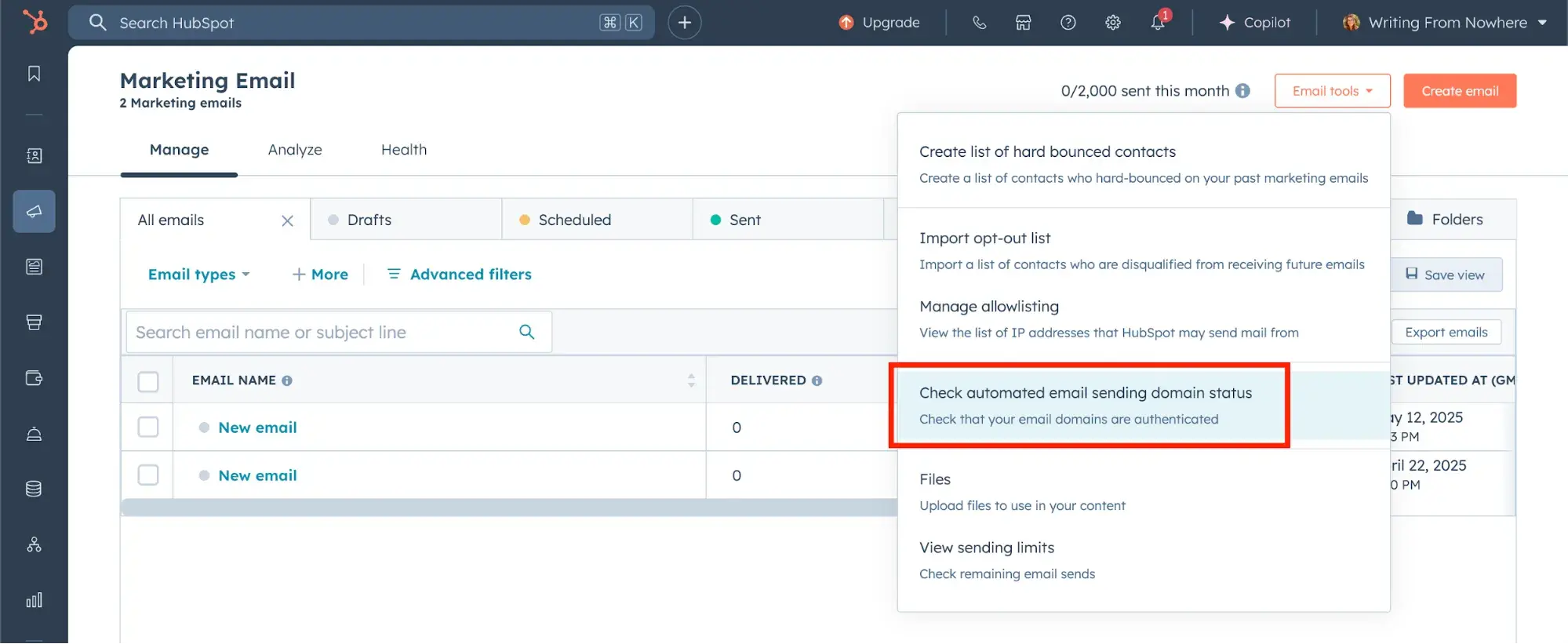
DMARC
DMARC (Domain-based Message Authentication, Reporting and Conformance) is another safeguard against email spoofing. DMARC is required by many inbox providers, like Google and Microsoft. Emails that don’t meet authentication standards will bounce, classified as a DMARC or policy bounce.
Sender Policy Framework (SPF)
Another form of email authentication is the Sender Policy Framework (SPF). This verifies that the sending email server is allowed to send bulk emails on behalf of that specific domain.
Transport Layer Security (TLS)
Missing transport layer security (TLS) encryption was another trend that DeLuke quickly cited as a cause for reputable brands being sent to spam.
What does TLS encryption do? It protects your messages from being maliciously read by people other than the intended recipients. Google equates unencrypted emails with postcards that are able to be read by snoopers in the mail.
Other Technical Factors
While it may seem like everyone and their mother has an email list these days, it’s an incredibly regulated and technical form of marketing. Sometimes your email sender reputation is negatively impacted by invisible technical issues with your IP address and domain. If you have an IT team, get them involved.
If you’re a HubSpot customer, a human member of our support team (yep, human — we’re big fans) can help 24/7 to explain the technical processes to you.
Bounce Rate
A bounce is a non-delivery event, meaning there was either a temporary or permanent problem with delivering to a recipient’s address. When using an ESP (email service provider) to send bulk email on your behalf, bounces are typically processed and parsed out in-app, making it easy for you to understand what happened.
If you’re a HubSpot user, you can learn about bounces on the recipients tab in the post-send details of an individual email campaign. There, you can find which emails have hard bounced or soft bounced.
A hard bounce indicates that there was a permanent error with delivery to a specific contact. For example, a contact’s email address may be invalid, unknown, or the recipient’s server has rejected mail from your domain or IP.
Built-in protection: At HubSpot, we suppress hard bounces from future sends, protecting your sender reputation and deliverability from further damage.
Soft bounces, on the other hand, are temporary issues that can occur for many reasons but can ultimately be resolved. We’ll cease any attempts to deliver the original email that resulted in a soft bounce, but the contact is not marked as ineligible for future sends (more about bounce classifications here).
A non-delivery report (AKA a bounce) comes directly from the recipient’s server. Contrary to some beliefs, bounces are not made up by, nor are contacts blocked from sending by, ESPs.
Behavior Associated With Spam
You’ve probably heard the rumor that using big numbers or ALL CAPS in your emails can send you to spam. That’s true: Because internet service providers are training their algorithms to learn from malicious senders.
Some spam email behavior is so commonplace that it’s made its way into pop culture — I’ll always think of The Office’s Michael Scott when this topic comes up. In the 25th episode, Michael is asked, “Didn’t you lose a lot of money on that other investment, the one from the email?” He shoots back, “When the son of the deposed king of Nigeria emails you *directly* asking for help, you help.”
Yep, the Nigerian prince scam; it’s a classic. But new spammy behaviors will always arise, and they won’t all be as obvious as this.
Real-life example: Amanda DeLuke was sending emails for a company with a great domain reputation, but one specific email was landing in the spam folder. After studying the email and testing small changes, she discovered that a single word with two hyphens (the word was editor-in-chief) was triggering spam filters. She removed one of the hyphens, and the email was delivered as intended. This could be caused by malicious senders who are emailing words with double hyphens (like “you’ve won--click here to claim prize”).
Email Frequency
How often you communicate with your email list can indirectly impact your sender reputation. If you’re not in communication enough with your email subscribers, it’s natural for some of them to forget that they subscribed. When you finally reach back out, they might have forgotten who you are.
I made this mistake with my blog’s email list back in the day. I let my email list get cold (ice cold, as in, it had been years without an email), then suddenly started emailing again after two years. People forgot who I was. A handful of readers marked the emails as spam, and I don’t blame them. Building trust requires you to show up. Those sudden spam complaints had a direct impact on my sender reputation.
Any spike in email frequency can impact your email deliverability — learn more in our email deliverability guide.
How to Check Your Email Sender Reputation
There are several ways to check your email sender reputation, starting with the HubSpot Email Health score.
HubSpot Email Health Score
HubSpot users can check their reputation with their built-in email health tool. It takes a minimum of 400 emails per month to gather enough data, so this is something that new senders will have to work their way up to.
This tool pulls data points from your email opens, click-throughs, hard bounces, unsubscribes, and spam complaints. Built-in benchmarking helps you measure your emails against averages.

I love that you can check the health score of all emails, but also of specific campaigns. This offers a deeper dive into your email sender reputation compared to free tools that only skim the surface.
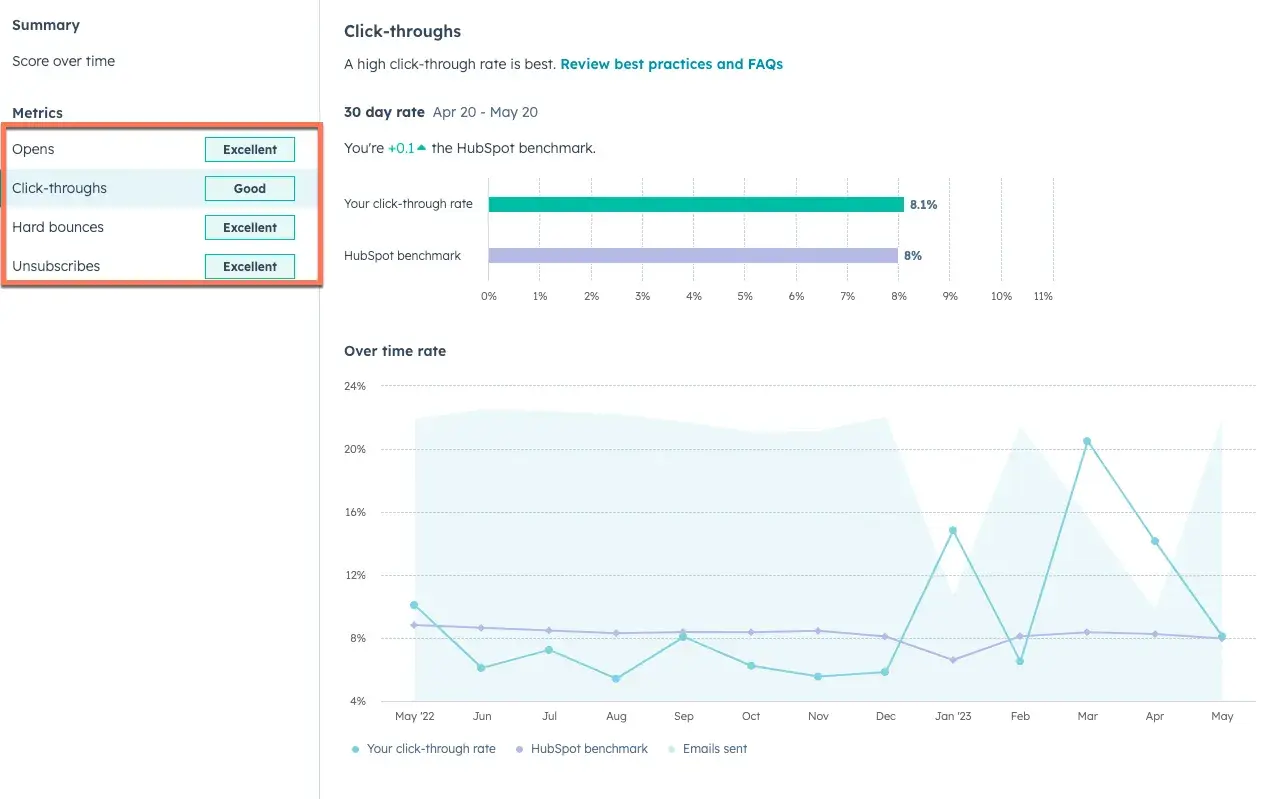
Scan with Sender Score.
A quick Sender Score scan will provide a numerical value between one and 100 that represents your email sender reputation. You enter your domain or IP address, click Let’s go!, and then input some personal information for access to your score.
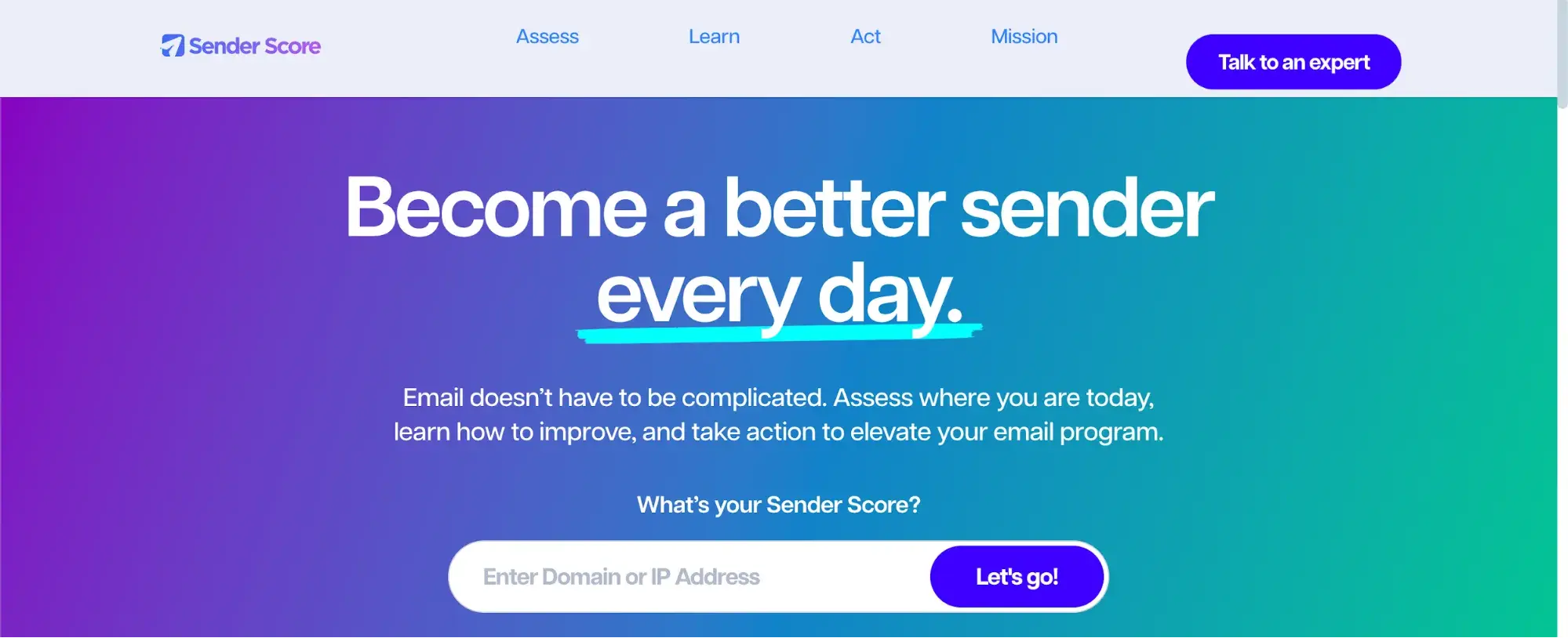
Watch open rates.
Can you gauge sender reputation through open rates? Not explicitly, but you can get an idea of where you stand. Email deliverability expert Jess Swazey shared these numbers as a rule of thumb:
- Open rates above 25% - Your brand’s sender reputation is healthy, and mail is landing in the primary inbox.
- Open rates between 15-25% - Your mail isn’t necessarily landing in spam, but your brand could benefit from further optimization.
- Open rates below 15% - Your mail might be landing in the spam folder.
- Open rates of 10% or less - Much of your messaging is likely being delivered to spam folders.
Learn more in our spam folder guide.
Monitor results manually.
Remember how Amanda DeLuke found out an email was being sent to spam because of a double hyphen? That insight only came from ongoing human monitoring and tweaking. You should routinely check how your emails are performing.
The HubSpot email health tool helps with this. It pulls data from your emails automatically and summarizes key points for you inside your dashboard:
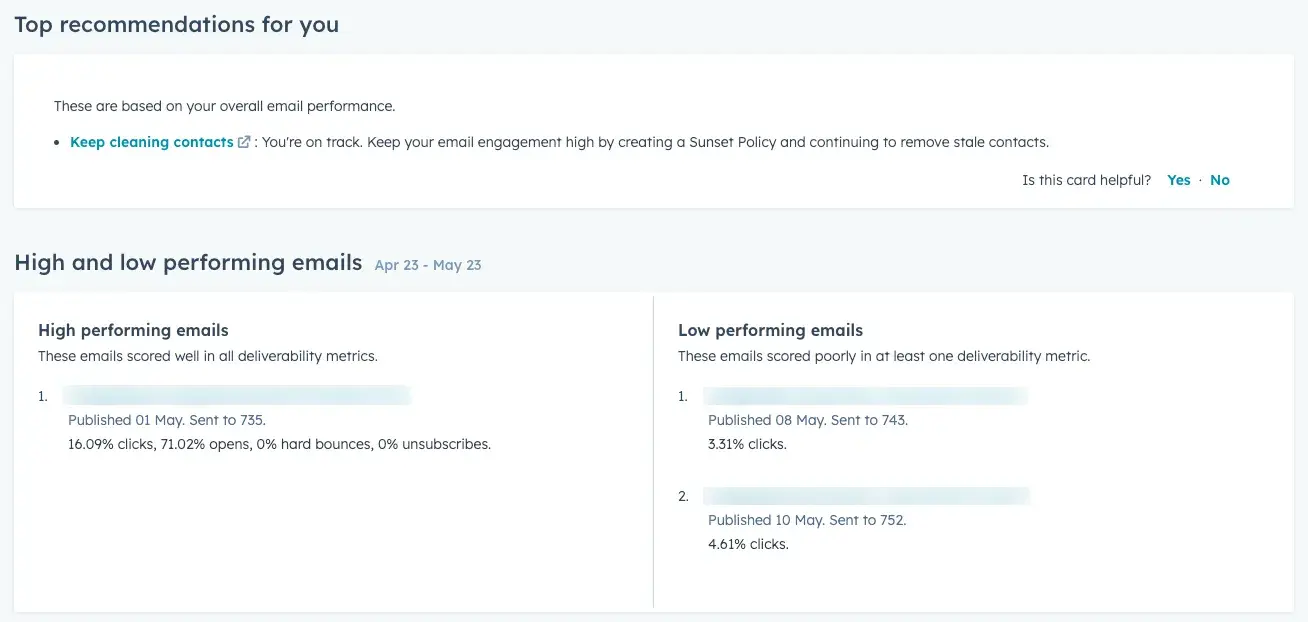
How to Improve Your Sender Reputation
Good news: Your email sender reputation is shaped by every interaction subscribers have with your emails. This means that if you send the right email today, you can start improving it immediately. Here’s how to get started.
1. Handle DMARC.
DMARC configuration (plus DKIM, SPF, and TSL) is included in the Starter Plans in our Marketing Hub, Sales Hub, Service Hub, and Content Hub. You will see “Missing record” in your HubSpot account if this authentication is missing:
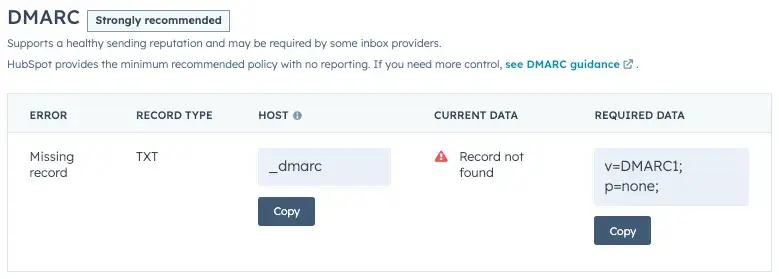
You can also scan your website on EasyDMARC to see at a glance if authentication is missing for your domain. As a test, I scanned my new website, Walk the Camino Portugués.
I haven’t started building my email list for this website yet, so email authentication is untouched on my to-do list. EasyDMARC shared this important warning that I hadn’t considered: My domain is at risk for spoofing. Now that this is on my radar, I’ll set up my domain so that I’m safeguarded.
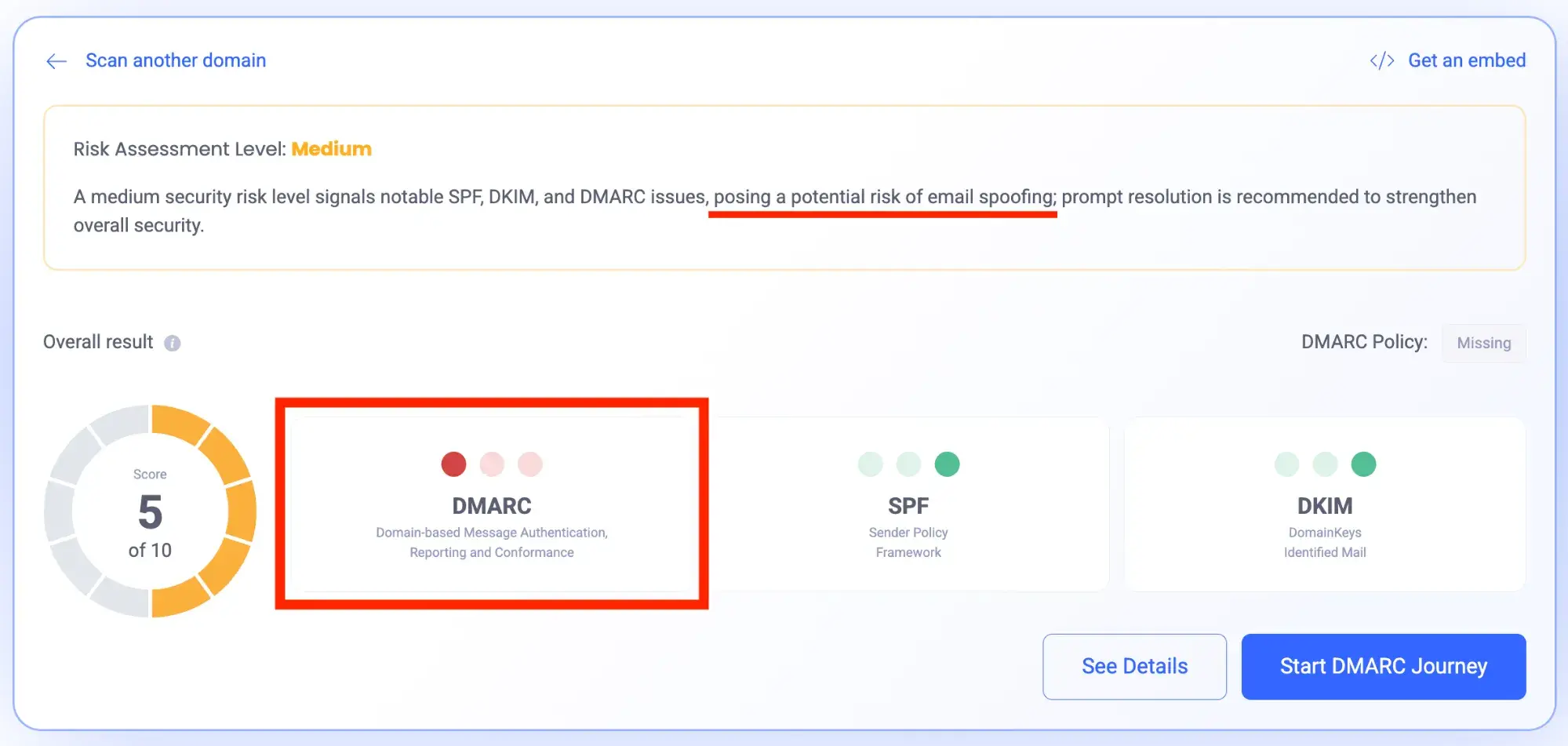
2. Handle SPF.
When your SPF record is missing, you’ll see this message inside your HubSpot account:
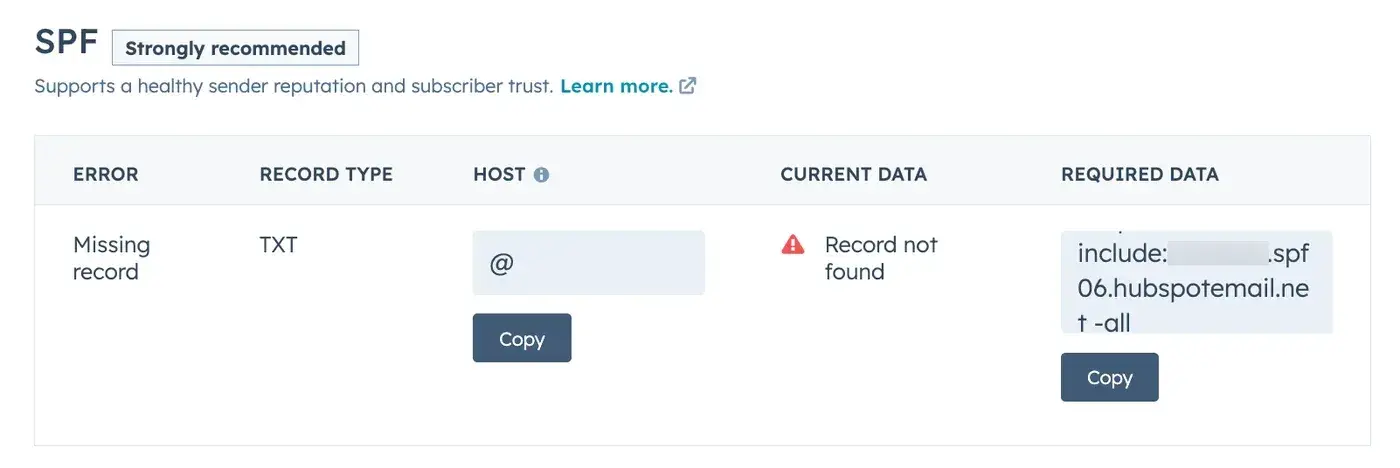
A missing SPF record will also show up on an EasyDMARC scan. Here are SPF tutorials for Microsoft, Mailchimp, and Mailerlite.
3. Handle DKIM.
You will need access to your domain name system (DNS) provider to complete DKIM configuration. You can see if your record is missing inside your HubSpot account, and we’ll walk you through adding it:
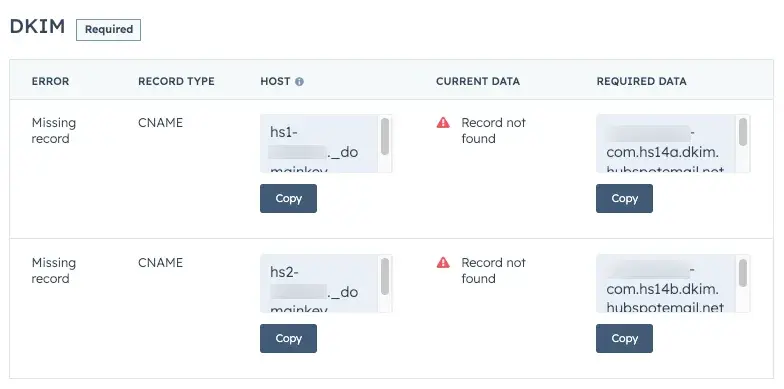
A missing DKIM record will also show up on an EasyDMARC scan. Here are DKIM tutorials for Microsoft, Mailchimp, and Mailerlite.
4. Abide by regulations.
Email marketing is highly regulated. The U.S. has the Federal Trade Commission (FTC). Europe has the European Data Protection Board. Canada has the Anti-Spam Legislation (CASL). The U.K. has the Privacy and Electronic Communications Regulations (PECR). The African Union has the Data Policy Framework (DPF). India has the Information Technology Act (ITA). This list goes on.
Each regulatory body has its own rules to abide by, but some of the most overlooked rules in the U.S. are:
- Only adding emails when you’re granted permission.
- Using double opt-in (required in some countries).
- Always offering a clear unsubscribe button.
- Listing a physical address.
This is just the tip of the iceberg — this guide covers other legalities of global email marketing.
Inside every HubSpot account, you have ongoing education to help you stay on top of best practices:
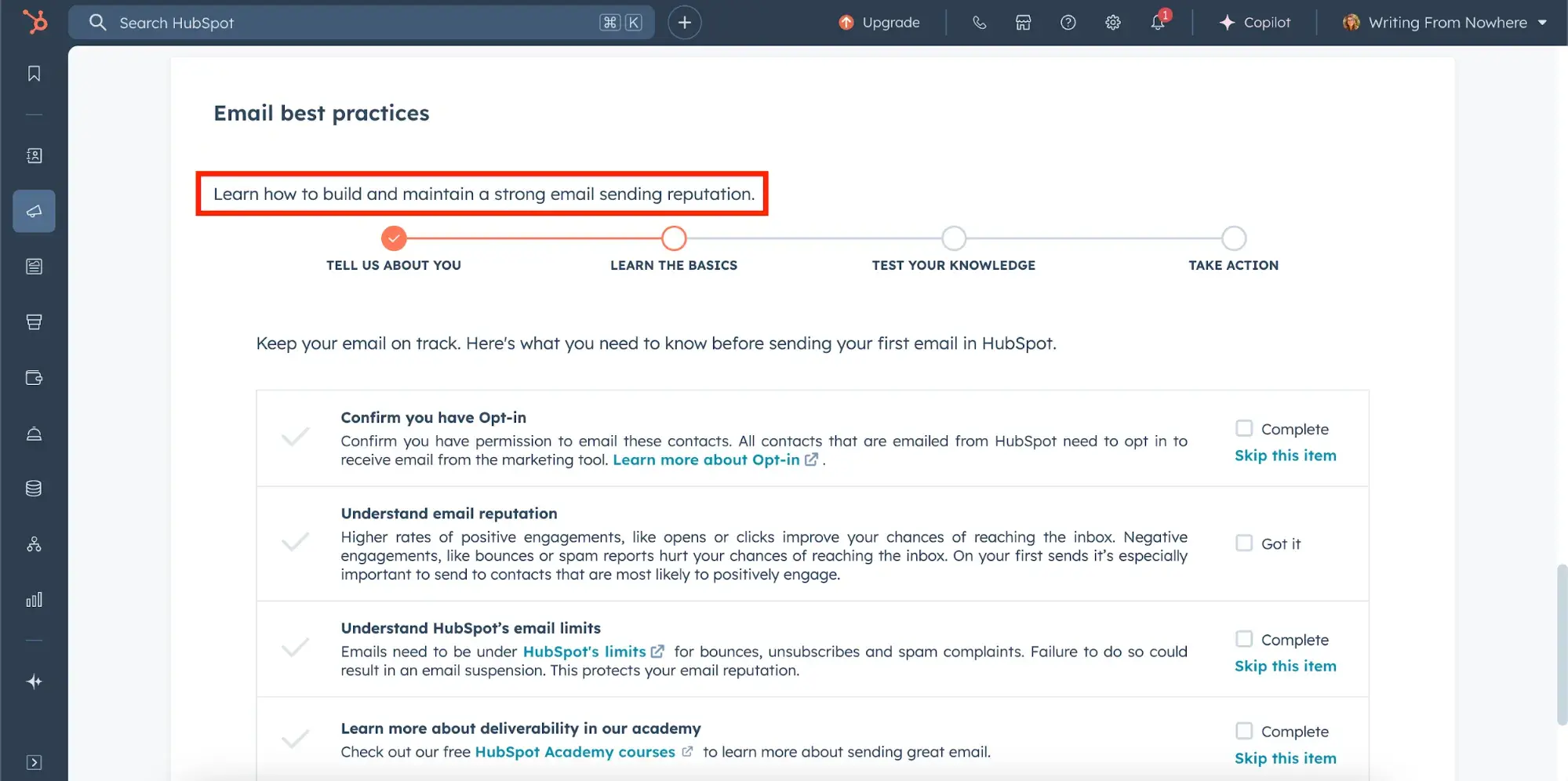
Following the rules is non-negotiable for success, but DeLuke warns, “You actually have to go way beyond what the laws require. It’s all about that reputation with the human on the other side.” That’s where the next few steps come in.
5. Send emails.
A good email sender reputation can only be achieved by sending emails and earning those reputation points. Just as you have to spend money on a credit card to build up a credit score, you have to repeatedly show up in customers’ inboxes to build up your email sender reputation.
6. Develop a symbiotic relationship with readers.
Your readers should think of your email relationship as a symbiotic one: You send a message to those who are interested, and in return, they open and engage with it.
Why this matters to your email reputation: You score reputation “points” with every engagement, and your contacts get information that adds value. This includes:
|
Positive Engagements |
Negative Engagements |
|
|
This isn’t a conclusive list, but it is a good starting place.
7. Ask for email engagement.
Score engagement points by asking for the engagement that you wish to receive. Here are two easy ways to achieve this:
- Ask as a favor. Outright ask your inner circle to respond to your bulk emails.
- Encourage organic replies. Pose a question to readers in each email, and make it clear that you want them to hit “reply.”
I love that this brings the human element back to email. Here’s an example currently sitting in my inbox from an online community that I’m a part of. They repurposed a question that was posed within the paid membership, shared a few of the answers it received, and asked for my reply.
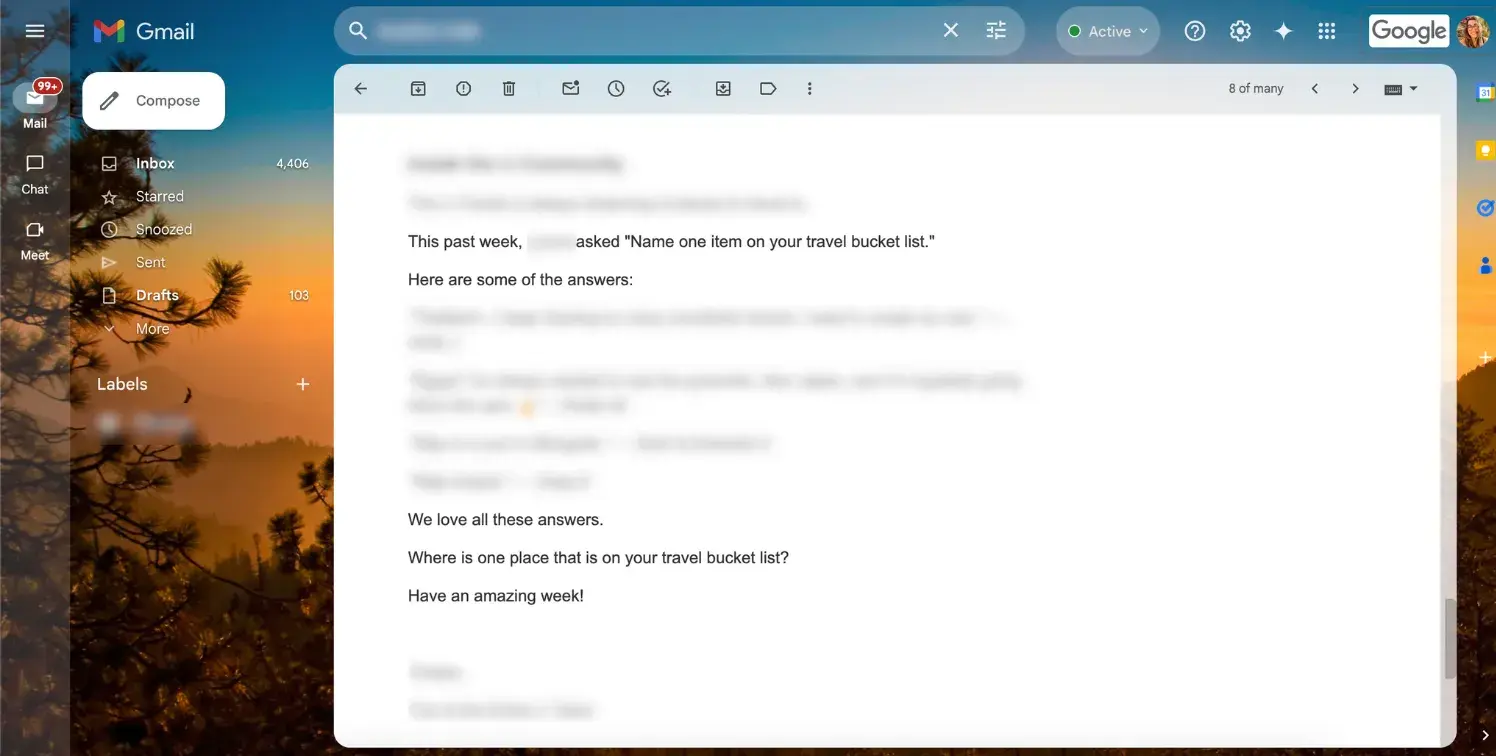
8. Check bouncing contacts.
The next time you review your marketing email performance, look at the bounce rate.
Metric: If your hard bounce rate is at 1% or higher, it is a signal that your emails are not reaching their intended audience, and your sender reputation may be suffering.
What can you do now to recover from higher-than-average bounce rates? Consider these three easy steps for getting your bounce rate under control:
- Segments. Send to smaller segments of your contact lists to drive engagement.
- Tiered sends. Send to your most engaged contacts first. If they open and engage with your mail, you know for sure it reached the inbox. Slowly layer in less engaged contacts.
- Cleanup. Implement a contacts database cleanup strategy, such as a sunset policy, to regularly remove SPAM traps and unengaged contacts.
Hard bounces are so damaging that they deserve a special moment in the spotlight.
9. Remove hard bounces.
Every email sent to an ineligible or unengaged contact means your sender reputation takes a hit. Even worse, this kind of behavior trains ISPs to place your mail directly into spam, as opposed to the inbox.
High hard bounce rates are an indication of poor list health and a signal that it is time to clean up your contacts database. Paying close attention to hard bounce rates can also help uncover problematic contact sources, as well as explain lower-than-average open rates and click-through rates. You can learn more about this in our bounce rate guide.
Reminder: HubSpot does this automatically to protect your email sender reputation, but in other software, you’ll need to do this manually.
Keep Your Sender Reputation Clean
I used to think that only bad marketers had poor sender reputations, but I was wrong. Between the different types of authentication and all the ways to earn engagement points, there’s a whole science behind what lands in your primary inbox and what disappears into the email abyss.
Maintaining a positive email sender reputation is a moving target, but it’s a worthy one if you’re investing in an email strategy.
Editor's note: This post was originally published in February 2019 and has been updated for comprehensiveness.
Email Deliverability


